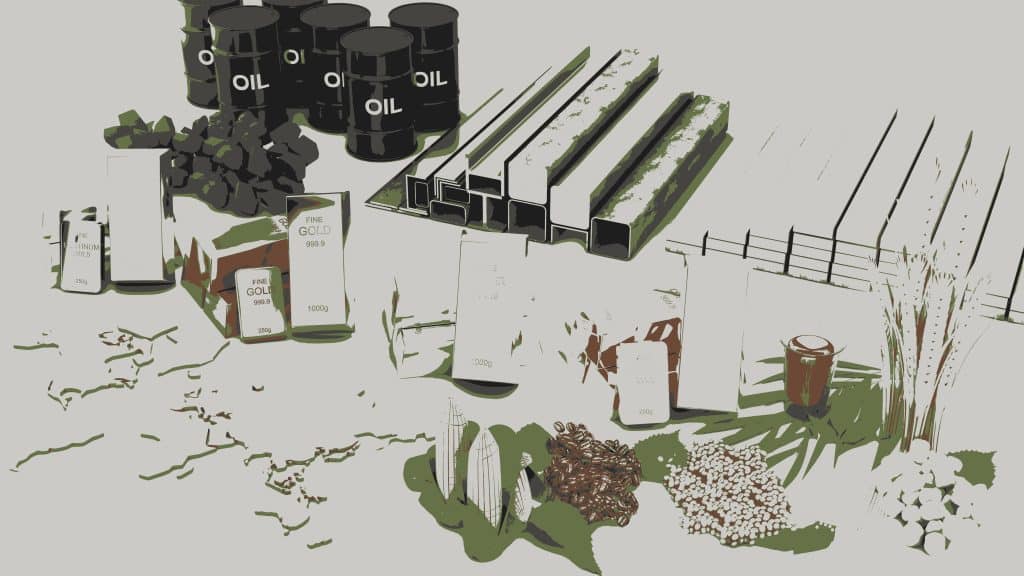Unlock the potential of diversification and hedge against inflation by investing in commodities, the tangible assets that power the world.

Investing in commodities can provide a powerful way to diversify your portfolio, protect against inflation, and potentially profit from the global demand for tangible assets ranging from precious metals and energy resources to agricultural products and industrial materials.
Investing in commodities is a great way to diversify your portfolio and generate investment gains. However, it can be risky if you don’t know what you’re doing.
This blog post will provide a beginner’s guide to investing in commodities and everything you need to know to start investing.
Types of Commodities
Before investing in commodities, you should understand the different types of commodities that offer investment opportunities. Commodities are broadly classified into four categories: energy, metals, agriculture, and livestock.
Each commodity has its own characteristics, supply and demand dynamics, and market price fluctuations. It’s essential to understand the factors that influence commodity prices before investing.
Let’s look at each type of commodity in detail.
Energy commodities
Energy commodities refer to natural resources that produce energy, including oil, natural gas, coal, and uranium. Energy commodities are essential to global economic growth and are used for power generation, transportation, and industrial production.
Investing in energy commodities can provide investors with diversification benefits and the potential for capital appreciation. At the same time, the energy market can be influenced by factors such as global economic conditions, supply and demand, and even geopolitical events.
Precious Metal commodities
Metal commodities refer to naturally occurring metallic elements mined, processed, and used in various industries.
The most commonly traded metal commodities include:
Investing in metal commodities can provide investors with diversification benefits, hedge against inflation, and offer the potential for capital appreciation. However, factors such as global economic conditions, supply and demand, and geopolitical events can influence the metal market.
Agriculture commodities
Agriculture commodities refer to crops and other products grown and harvested for human consumption, animal feed, or industrial use.
The most commonly traded agricultural commodities include:
- Corn Commodities
- Wheat Commodities
- Soybeans Commodities
- Coffee Commodities
- Cotton Commodities
- Sugar Commodities
Investing in agricultural commodities can provide investors with diversification benefits and serve as a hedge against inflation. However, the agriculture market can be influenced by various factors such as weather conditions, supply and demand, and government policies.
Livestock commodities
Livestock commodities refer to animals raised for meat, dairy, or other products. The most commonly traded livestock commodities include cattle, hogs, and poultry.
Investing in livestock commodities can provide investors with diversification benefits and serve as a hedge against inflation. However, the livestock market can be influenced by various factors such as weather, supply and demand, and changes in government policies.
How to Invest in Commodities
There are two ways to invest in commodities, direct investing, which involves buying and holding physical commodities such as gold, silver, crude oil, or agricultural products.
The other way to invest in commodities is through indirect investments, where investors buy shares in companies or funds that invest in commodities.
Indirect investments allow investors to gain exposure to the commodities market without physically buying them. You can indirectly invest in commodity stocks, ETFs, and mutual funds through an online brokerage like eToro.
Let’s look at the different ways to invest in commodities.
Physical Ownership
Investors can buy physical commodities such as gold, silver, platinum coins or bars, crude oil, or agricultural products like soybeans or wheat. The commodities can be stored at home or in a secure storage facility.
Exchange-Traded Funds (ETFs)
Commodities ETFs are investment funds that trade on stock exchanges and hold a basket of commodities or commodity-related assets. Investors can buy and sell ETF shares like stocks. There are several types of commodity ETFs, including gold, silver, wheat, livestock, and even fertilizer ETFs.
Mutual Funds
Mutual funds are investment vehicles that pool money from multiple investors to invest in commodities-related securities, such as commodity futures contracts or stocks of companies involved in producing and distributing commodities.
Commodity-focused Stocks
Investors can buy shares of companies involved in producing, exploring, or distributing commodities. These companies may be directly involved in extracting or processing the commodity, or they may provide services to the industry.
Commodity Futures
Investors can buy and sell futures contracts for commodities, which allows them to speculate on the future price of the commodity. Futures contracts are agreements to buy or sell a specific commodity at a future date and price. Commodity futures provide traders with contracts of a set unit size, a fixed expiration date, and centralized clearing.
Factors That Influence Commodity Prices
Several factors can impact commodity prices. The following are some of the key ways in which economic conditions affect commodities prices:
Inflation
Inflation can have a significant impact on commodity prices. When inflation increases, currency’s value decreases, making commodities relatively more expensive. As a result, investors may turn to commodities as a hedge against inflation, leading to an increase in demand and prices.
Geopolitical risks
Political instability and conflicts can also impact commodity prices. Disruptions in the supply chain due to conflicts or natural disasters can lead to a decrease in supply and an increase in prices.
Exchange Rates
The exchange rate between currencies can also impact commodity prices. If a commodity is priced in one currency and the exchange rate between that currency and another currency changes, the price of the commodity will also change. For example, if the US dollar weakens against the euro, the price of gold, which is priced in US dollars, may rise.
Supply and Demand
The most important factor affecting commodity prices is supply and demand. If demand for commodity increases, but the supply remains constant, the commodity’s price will rise.
Conversely, if the supply of a commodity increases while demand remains the same, the price will fall. Economic conditions, such as changes in consumer preferences, global economic growth, and technological advancements, can all affect supply and demand.
Conducting Research
Conducting research for commodities involves analyzing various factors that can impact the prices of different commodity markets.
Here are some key steps to follow when conducting research for commodities:
Analyze supply and demand
The supply and demand of a commodity are the most significant factors that determine its price. Researching the supply and demand of a commodity involves analyzing various factors such as production levels, inventory levels, consumption patterns, and import and export data.
Monitor economic indicators
Economic indicators such as GDP growth, inflation rates, and interest rates can significantly impact the prices of commodities. Monitoring these indicators can provide insights into the global economy’s health and help forecast future commodity prices.
Analyze geopolitical events
Geopolitical events like trade wars, political instability, and natural disasters can also impact commodity prices. Researching geopolitical events involves monitoring news outlets and analyzing the potential impact of these events on specific commodity markets.
Use technical analysis
Technical analysis involves using charts and statistical data to identify trends and patterns in commodity prices. This analysis can help identify potential entry and exit points for commodity trades.
Stay informed
Staying informed about global events and market news is crucial when researching commodities. Regularly reading news outlets and following commodity experts can help you stay up-to-date on the latest developments in commodity markets.
Overall, conducting research for commodities requires a combination of fundamental analysis, technical analysis, and staying informed about global events and market news. By following these steps, investors can make more informed decisions when investing in commodity markets.
5 Reasons to Invest in Commodities
Commodities investing offers several advantages to investors, including:
1. Correlation
Correlations are measured on a scale of -1 to +1, with a correlation of +1 indicating a perfect positive correlation (i.e., when two variables move in the same direction), 0 meaning no correlation, and -1 showing a perfect negative correlation (i.e., when two variables move in opposite directions).
Commodities provide diversification benefits to investors because they tend to have a low correlation with stocks and bonds. Still, it’s worth noting that the correlation can vary depending on economic growth or a contraction in the global market.
Commodities and stocks can be positively correlated when there is strong global economic growth or expansion. In this case, demand for commodities such as oil, metals, and agricultural products increases, leading to higher prices. This, in turn, benefits companies that produce and sell these commodities, boosting their stocks.
However, commodities and stocks can also be negatively correlated during a global economic downturn. In this case, demand for commodities falls, leading to lower prices. This can harm companies that produce and sell these commodities, causing their stocks to decline.
2. Inflation hedge
Commodities tend to perform well during inflationary periods because they are tangible assets with intrinsic value. Investing in commodities can, therefore, provide a hedge against inflation and help maintain purchasing power.
3. Potential for capital appreciation
Like any other asset class, commodities can provide the potential for capital appreciation. Changes in supply and demand dynamics, geopolitical events, and other factors can impact commodity prices and provide opportunities for investors to profit.
4. Access to global markets
Commodities are traded on global markets, allowing investors to access investment opportunities in various regions of the world.
5. Tangible assets
Commodities are tangible assets, meaning they have intrinsic value that is not dependent on a company’s performance or the stock market. This can provide a sense of security for investors who prefer to invest in physical assets.
Disadvantages of Commodities
Commodity investing can also have some disadvantages for investors, including:
Volatility
Commodity markets are often volatile and subject to sudden price fluctuations. Prices can be impacted by factors such as global economic conditions, geopolitical events, weather patterns, and supply and demand dynamics. This volatility can make commodity investing risky and potentially lead to significant losses for investors.
Lack of income
Unlike stocks and bonds, commodities typically do not provide income through dividends or interest payments. This means that investors are solely dependent on capital appreciation for returns.
High costs
Investing in commodities can be expensive due to the high transaction costs associated with trading physical commodities such as storage, transportation, and insurance. Commodity ETFs and mutual funds can be more cost-effective but still have management fees and other expenses.
Limited liquidity
Some commodity markets are relatively illiquid, meaning buying or selling commodities quickly can be challenging without significantly impacting their price. This lack of liquidity can make it difficult for investors to exit positions or manage risk effectively.
Lack of control
Investing in physical commodities such as gold or oil involves a lack of control over the asset, as investors cannot control the supply or demand dynamics of the market. This lack of control can make it difficult for investors to predict or manage risk effectively.
Commodity investing can be volatile and expensive, with limited income potential and liquidity. Investors should carefully consider these factors before investing in commodities and ensure that their investment objectives and risk tolerance align with the potential risks and rewards of commodity investing.
The Bottom Line
Investing in commodities can provide investors with diversification, an inflation hedge, and the potential for capital appreciation.
Commodities are tangible assets that offer access to global markets, providing investors opportunities to invest in various regions worldwide. However, commodity markets can be volatile, and the costs associated with trading physical commodities can be high. Some commodity markets are illiquid, with limited control over the assets invested.
Investors should carefully consider the potential risks and rewards of commodity investing and ensure that their investment objectives and risk tolerance align with the unique characteristics of commodity markets. Conducting thorough research and consulting with a financial advisor can help investors make informed decisions about investing in commodities.




